The Italian summer guide to Puglia
Be a Better Traveler shares the best towns, food, wine, and history in Italy's deep south
You have heard me say it before. Italian summer is the best summer. Long lunches, all day lounging under a stripey umbrella, midnight gelato, I mean really, what is better than that? Each year as the days become longer and warmer I have great intentions to branch out and visit new places. And then I just go back to Ponza. I find great comfort in revisiting a place that knows you well. This is not the summer for me to add more new things to the agenda so I have asked my pal Rebecca Holland, who among many other things writes the information packed newsletter Be a Better Traveler, to share her favorite things about Puglia.


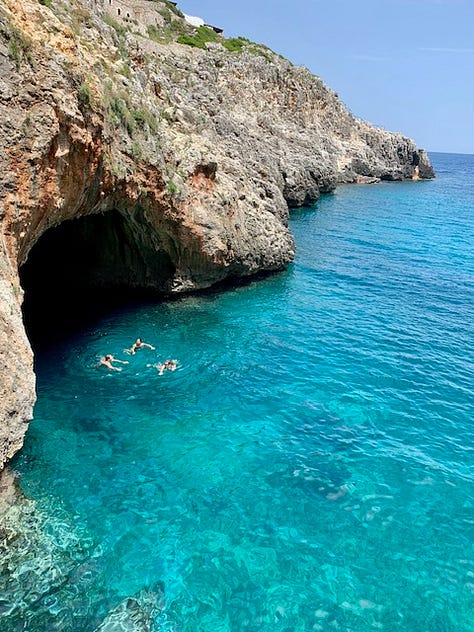
How to be a Better Traveler In Puglia
Puglia is one of my favorite regions in Italy. The heel of the country’s boot is known for its sparkling blue coastline, fresh seafood, olives, and unique architecture.
Bari is the capital of Puglia and sits on the Adriatic Sea. It’s a good base, and you’ll want to rent a car. Driving is the easiest way to get around the region and as you’ll start to notice there are lots of small towns that are great for a day trip or lunch. There’s so much to see you’ll want to stay for months. Sadly, that isn’t possible for most of us. If you have a week or so, visit Bari and Matera, with maybe a day in Polignano a Mare (for beaches) or Altemura (for food). Or, you could spend a week in the southern part of Puglia––Salento. Base yourself in Lecce and visit Ostuni and Gallipoli.
Airbnb is the most economical long-term rental option in Bari. In 2019, an apartment for nine weeks was about $800. For shorter trips, there are plenty of hotel options in Bari and Lecce, and masserie (sort of high-end farmhouses on estates, usually including meals), are popular in the region and a really lovely way to spend a few nights. Here are a few favorite spots.
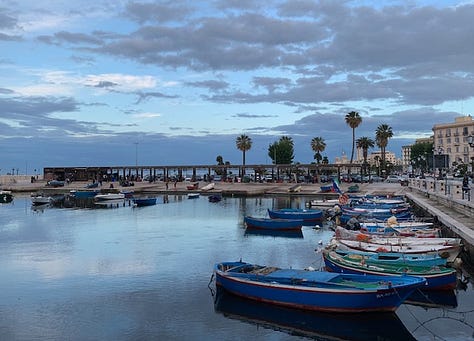

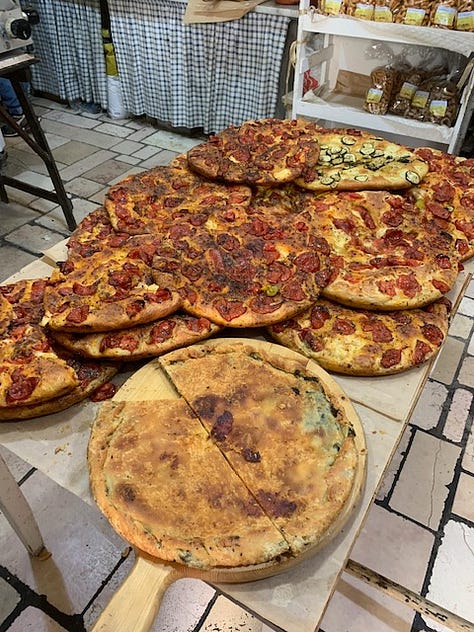
Bari : Things to Eat
You cannot leave without multiple stops at the fish market, where you’ll find raw octopus, mussels, sea urchin, and more. Don’t know how to eat it? No problem. The fishermen are happy to help. Grab a plate of seafood and a couple of beers from the adjoining stand, and dine with views of colorful fishing boats.
Bari is famous for its focaccia, perhaps nowhere more so than Panificio Fiore Bari in the old part of the city. Get the focaccia Barese, the style topped with ripe tomato, olive oil, and sometimes olives. Another famous spot is Panificio Santa Rita. You’ll know it from the ever-present line out the door. Out of the old city, one of my favorites is La Pupetta, especially for white focaccia.
There are dozens (maybe hundreds?) of bars (for coffee) in Bari, but Meridional Caffe stands out for its espresso freddo.
Panzerotti are essentially little deep fried calzones, and Pizzeria di Cosimo (the location in the old city) makes my favorite. They also have great pizza and it’s fun to sit outside on a summer night. The restaurant draws tourists, but the square is mostly local and buzzes with children running around and their chattering parents.
For seafood, Biancofiore is lovely, as is Al Pescatore (the spaghetti alle vongole here is my favorite). On the fancier side, try Ai 2 Ghiottoni, where the seafood is wonderful, but I get especially giddy about the alcohol drenched strawberry liqueur and cookie tray at the end of the meal. For all things Pugliese with a modern spin, go to Terranima.
You’ve likely read stories about Bari’s pasta grannies, who make and dry orecchiette on tables in Bari Vecchia and were the subjects of a NYT piece titled ‘Call It a Crime of Pasta.’ If you’re staying in an Airbnb or anywhere with a kitchen, buy bags and cook it yourself. You’ll also see orecchiette, usually served with cime di rape , on almost every menu. For other types of fresh pasta, I love Pastificio Ancora Di Marco, Ancora & Fiore, and La Bottega del Tortellino.
Taralli (ring-shaped dense crackers made with olive oil, flour, salt, and white wine) are one of my favorite snacks in the world, and though you can find them around Italy, they’re best in Puglia, where they’re from. Fennel is the most common, but there’s also onion, spicy pepper, and more.
Most people visit Bari in the summer to take advantage of the large, free beach (very cutely called Pane e Pomodoro). If you’re walking back to town from the beach, stop at Pescobar for a takeaway fish sandwich you can eat on a bench by the water.
In the old city, Voglia..Pane e Vino is a nice bar with lots of local wine and cheese platters. The staff are fabulous and can tell you all about the wines (which are also incredibly cheap). Ciclatera Under the Sea is also nice for a spritz with a view.
There’s gelato and granita galore, and I encourage you to try it all. That said, Gelateria Gentile is especially good for both.
Things to Do
The Museo Teatro Margherita features cool exhibits, like a recent Banksy retrospective and the World Photography Awards. The 12th century Basilica di San Nicola has a crazy story. It was originally built to house the relics of St. Nicholas. Yes, that St. Nicholas. Sailors from Bari supposedly stole the relics from a church in Antalya, Turkey in 1087. (This has been disputed in recent years). Either way, the church is an important pilgrimage place for Catholics and Orthodox Christians. You should also visit the Museo Archeologico di Santa Scolastica, which has interactive exhibits that take you through Bari’s history.
Want to buy those pretty plates you keep seeing at restaurants? Il Ficodindia is the place to go for ceramics. (I first found Il Ficodindia, and a few of these restaurants, through Elizabeth Minchilli, who also has many, many wonderful Puglia tips and leads tours around the region)
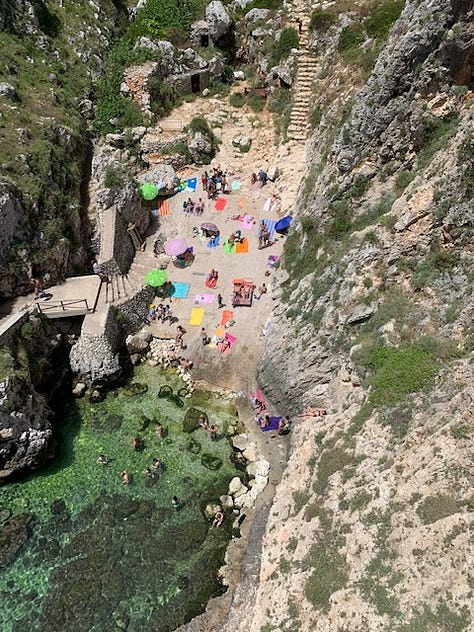

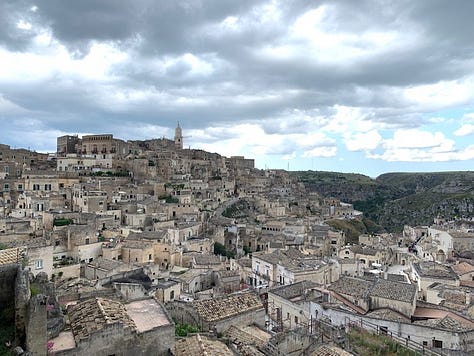
Polignano a Mare
Polignano a Mare can be crowded with tourists and is quite small, but it’s nice for a day trip from Bari. The beach is gorgeous, as are the viewpoints around town. Give into tourism and have a glass of prosecco here, where you can take it all in. Pescaria is a lively fish sandwich shop that seems to embody everything Polignano a Mare is: beachy chic. After a day at the beach, cool down with granita from Il Super Mago del Gelo.
Gargano National Park/Peschici
If you’re craving nature, visit Gargano National Park to hike through forests or see the Tremiti Islands. On the way, stop in Vieste, a coastal town on a limestone cliff with nice beaches. On the way home, stop in Peschici for dinner at Costamarina Restaurant and Wine Bar. I dream about the squid ink pasta here. The sunset views are pretty spectacular too.
Monopoli
A very cute, seaside town that was once an important hub for the Roman Empire. It’s tiny, but good for a road trip stop or day trip. Spend some time walking around the whitewashed town, then have lunch at Carlo Quinto.
Altamura
You go to Altamura for the bread and the cheese. Pane di Altamura is a protected Italian bread that has to be made with durum wheat flour, a starter with lactic acid, salt, and water. The dough must be kneaded for 20 minutes, then go through set resting phases before baking. It is most famously made at Forno Antico Santa Chiara, which has been around since 1423 (!!!).
Sit outside and order a platter of cheese and salumi, as well as anything with stracciatella. Then go to Caseificio Dicecca, the cheese shop owned by the “Burrata Brothers,” who make what many say is Italy’s best mozzarella. It might seem crazy to visit a town solely for bread and cheese, but once you taste it you’ll understand.
Salento
Salento is a sub-region of Puglia. My friend Antonio grew up there, and this is his mini guide: Sunset Cafe for aperitivo overlooking the sea and La Braceria Beach for choose-your-own grilled meats and vegetables. For breakfast, try Salentino snacks like pasticciotto, a pastry filled with cream, and rustico, a puff pastry filled with a sort of bechamel and tomato sauce. Salento’s beaches put the rest of the world to shame. Seriously. Visit Grotto della Poesia and Ponte Ciolo.
Spend a day wandering Gallipoli, which hsa everything from touristy tchotchke shops to swanky beach clubs. Punta Prosciutto, Torre San Giovanni and Porto Selvaggio are all pristine beach spots.
Lecce
You’re going to want to spend a couple of days in Lecce (which is part of Salento) marveling at the baroque architecture and ancient ruins. It’s known as the “Florence of the south.”
Visit the Basilica di Santa Croce, which took two centuries to complete. It was built partly from houses of Jews who had been expelled. Learn more about that at the Museo Ebraico, which traces the Jewish history of Salento.
Get sandwiches at Come Vuoi and coffee at Caffè Alvino. Wine and small plates at Mamma Elvira Enoteca (the main restaurant is good too), and dinner at La Torre di Merlino. Stop in Society Limonata for dreamy bedding and table linens.
Ostuni
I adore Ostuni. The whitewashed city has been inhabited since the Stone Age, and you could spend days wandering the many crooked side streets. My favorite restaurant here by far is Osteria del Tempo Perso. It’s cozy, the wine is cheap, the servers are friendly and quick with suggestions, and the meatballs are the best I’ve ever had. Outside of town, Masseria Moroseta is a beautiful estate with nightly group dinners. Saveur profiled the chef here.
Matera
Matera isn’t technically in Puglia, but it’s close enough. It’s been inhabited since the Paleolithic period, and the original cave dwellings are still intact. In 251 B.C, the “newer” parts of the city were built around them, and more modern additions have been added ever since. It’s a truly unique and beautiful place and I cannot recommend it enough. You’ve seen it in James Bond. If you stay the night, do it at Sextantio, a beautiful hotel with ancient walls and views and a wonderful restaurant.
Wine
Puglia is one of Italy’s largest wine regions. It’s known for the red Negroamaro, Primitivo and Nero di Troia grapes, and white Verdeca, Bombino Bianco, and Greco. This is primarily a red wine region, and if you like fruit-forward, full reds you’ll love Puglia reds. The rosé here (often made from Negroamaro) is also some of my favorite in Italy.
Negroamaro is a bitter, thick-skinned grape that makes wines that taste like raspberry and tobacco. If you’re not sure about it, try Primitivo, which is the same grape as California Zinfandel.
If you like acidic whites, try Greco Bianco, and for something you can drink alllll day long, go with Verdeca. Blends are also popular. Obviously, you should try them all!
There are so many more adorable towns, more fantastic lunch spots, more ancient history, more gorgeous beaches. This guide could go on and on! Have any additional Puglia questions or want recommendations for somewhere not mentioned? My name is Rebecca Holland and I write the Be a Better Traveler newsletter. You can find me there or on Instagram.





I love this collaboration between you and Rebecca, Gillian! Funnily enough, my husband and I were just saying a few minutes ago that we have never seen espresso freddo in Italy, which seemed odd to us...we have had (and loved) it in Greece and Cyprus, where they call it “freddo espresso.” So I was excited to see it pop up in this post!
Sounds beautiful, and what I need. But Would you recommend visiting if I’m traveling with a toddler? :) Any thing to avoid?